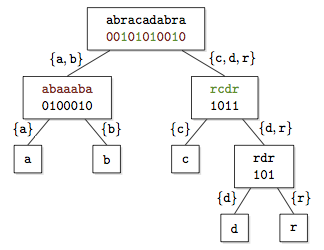Wavelet Tree

The Wavelet Tree is a succinct data structure to store strings in compressed space. It generalizes the and operations defined on bitvectors to arbitrary alphabets.
Originally introduced to represent compressed suffix arrays,[1] it has found application in several contexts.[2][3] The tree is defined by recursively partitioning the alphabet into pairs of subsets; the leaves correspond to individual symbols of the alphabet, and at each node a bitvector stores whether a symbol of the string belongs to one subset or the other.
The name derives from an analogy with the wavelet transform for signals, which recursively decomposes a signal into low-frequency and high-frequency components.
Properties
[edit]Let be a finite alphabet with . By using succinct dictionaries in the nodes, a string can be stored in , where is the order-0 empirical entropy of .
If the tree is balanced, the operations , , and can be supported in time.
Access operation
[edit]A wavelet tree contains a bitmap representation of a string. If we know the alphabet set, then the exact string can be inferred by tracking bits down the tree. To find the letter at ith position in the string :-
Algorithm access
Input:
- The position i in the string of which we want to know the letter, starting at 1.
- The top node W of the wavelet tree that represents the string
Output: The letter at position i
if W.isLeafNode return W.letter
if W.bitvector[i] = 0 return access(i - rank(W.bitvector, i), W.left)
else return access(rank(W.bitvector, i), W.right)
- "←" denotes assignment. For instance, "largest ← item" means that the value of largest changes to the value of item.
- "return" terminates the algorithm and outputs the following value.
In this context, the rank of a position in a bitvector is the number of ones that appear in the first positions of . Because the rank can be calculated in O(1) by using succinct dictionaries, any S[i] in string S can be accessed in [3] time, as long as the tree is balanced.
Extensions
[edit]Several extensions to the basic structure have been presented in the literature. To reduce the height of the tree, multiary nodes can be used instead of binary.[2] The data structure can be made dynamic, supporting insertions and deletions at arbitrary points of the string; this feature enables the implementation of dynamic FM-indexes.[4] This can be further generalized, allowing the update operations to change the underlying alphabet: the Wavelet Trie[5] exploits the trie structure on an alphabet of strings to enable dynamic tree modifications.
Further reading
[edit]- Wavelet Trees. A blog post describing the construction of a wavelet tree, with examples.
References
[edit]- ^ R. Grossi, A. Gupta, and J. S. Vitter, High-order entropy-compressed text indexes, Proceedings of the 14th Annual SIAM/ACM Symposium on Discrete Algorithms (SODA), January 2003, 841-850.
- ^ a b P. Ferragina, R. Giancarlo, G. Manzini, The myriad virtues of Wavelet Trees, Information and Computation, Volume 207, Issue 8, August 2009, Pages 849-866
- ^ H.-L. Chan, W.-K. Hon, T.-W. Lam, and K. Sadakane, Compressed Indexes for dynamic text collections, ACM Transactions on Algorithms, 3(2), 2007
- ^ R. Grossi and G. Ottaviano, The Wavelet Trie: maintaining an indexed sequence of strings in compressed space, In Proceedings of the 31st Symposium on the Principles of Database Systems (PODS), 2012
External links
[edit] Media related to Wavelet Tree at Wikimedia Commons
Media related to Wavelet Tree at Wikimedia Commons












